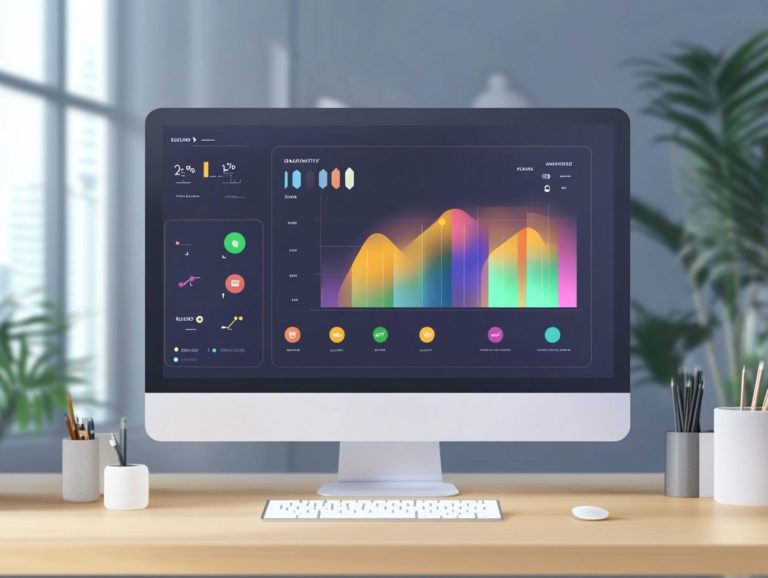Performance Management Tools: Customization Options
In today s fast-paced business landscape, mastering performance management is essential for driving employee engagement and achieving your organizational goals.
Performance management tools provide a structured approach to track and enhance employee performance, but their true value emerges through customization.
This article delves into how tailoring these tools can yield superior outcomes, explores the various customization options at your disposal, and presents practical examples of success. It also outlines best practices to ensure your customization efforts deliver the results you seek.
Explore how customization can transform your performance management strategy today!
Contents
- Key Takeaways:
- Benefits of Customization
- Common Customization Options
- Factors to Consider When Choosing Customization Options
- Examples of Customization in Performance Management Tools
- Best Practices for Customizing Performance Management Tools
- Frequently Asked Questions
- What are customization options in performance management tools?
- Why are customization options important in performance management tools?
- What are some common customization options in performance management tools?
- Can customization options be changed after initial setup?
- Are there limitations in customizing performance management tools?
- How can customization improve performance management?
Key Takeaways:

- Customization is crucial in performance management as it allows for tailor-made solutions that cater to specific needs and goals.
- When choosing customization options, consider your organization’s culture, budget, and technology compatibility for effective implementation.
- Real-world examples and best practices can provide valuable guidance for customizing performance management tools.
What are Performance Management Tools?
Performance management tools are vital software solutions designed to make it easier to assess employee performance. They help HR professionals and managers set performance indicators, track feedback, and conduct effective reviews that promote employee growth.
With a range of customization options, these tools can be tailored to fit the unique needs of your organization, enhancing workflow processes and cultivating a positive organizational culture.
Beyond just objective performance metrics, these tools often feature real-time feedback mechanisms that boost communication between team members and supervisors, fostering a culture of transparency. By integrating user-friendly elements, the software becomes intuitive for both employees and managers, encouraging regular usage and leading to sustained performance improvement.
As your organization navigates the rapid changes in the workplace, these tools support flexible work methods, enabling timely adjustments in goals and priorities. This adaptability contributes to a more dynamic and responsive organizational environment, ensuring you stay ahead of the curve.
Benefits of Customization
Customization in performance management tools provides you with substantial advantages, enhancing both usability and effectiveness within your organization. This flexibility allows for evaluation processes that align seamlessly with your strategic goals.
By harnessing adaptable features, you can develop tailored performance management software solutions that not only boost employee engagement but also streamline feedback mechanisms. This approach drives performance improvement by addressing the specific needs of your workforce.
How Customization Enhances Performance Management
Customization significantly elevates performance management by aligning evaluation processes with your organizational goals and individual employee performance metrics. This alignment enables you to derive actionable insights through continuous feedback.
By adopting a tailored approach, you enable managers to create flexible evaluation methods that cater to the unique circumstances of each employee, fostering accountability and growth while cultivating a culture of performance improvement.
Integrating specific feedback collection mechanisms allows you to effectively track both individual and team progress, adjusting strategies as necessary to meet overarching objectives. These tools not only streamline the evaluation process but also empower your employees to take charge of their development journeys, aligning their personal aspirations with the company s vision.
This alignment fosters a more engaged workforce, driving higher levels of motivation and productivity. Through ongoing dialogue, employees will feel valued and supported, leading to enhanced job satisfaction and reduced turnover. Ultimately, this benefits your organization in its pursuit of success.
Common Customization Options

In performance tracking tools, you’ll find a range of customization options crafted to elevate your user experience and tailor functionalities to fit your organizational needs, especially when considering performance management tools: software reviews and ratings.
Think flexible goal tracking, personalized performance indicators, and efficient compensation planning processes. These customization features enable you to adapt your performance review software in real-time, ensuring alignment with ever-evolving business objectives.
Key features and functions that you can customize in performance management software include the performance review processes, feedback collection methods, and analytics tools designed to track employee evaluations and performance metrics.
By tailoring these elements, you can create user-friendly interfaces that promote more effective communication and provide comprehensive insights into employee growth and performance improvement.
You can opt for anonymous feedback options or structured peer reviews, allowing you to align with your workplace culture and foster a more open environment for dialogue.
Various analytics tools can be implemented to assess trends over time, giving you a deeper understanding of both individual and team performance.
Customizable dashboards enable you to concentrate on specific Key Performance Indicators (KPIs), enabling you to make more informed decisions regarding employee development initiatives.
This flexibility helps boost employee engagement and effectively drive your strategic goals.
Factors to Consider When Choosing Customization Options
Choosing the right customization options for your performance tracking tools is crucial. You must consider several critical factors to ensure you choose the most effective software.
Pay particular attention to integration capabilities with your existing HR systems, as well as the overall user experience for both managers and employees.
A thorough evaluation of these elements can significantly impact the success of tracking performance metrics and the overall effectiveness of your performance management processes.
Key Considerations for Effective Customization
Key considerations for effective customization lie in your understanding of the unique needs of your organization and its workforce. It’s crucial to ensure that management insights are transformed into actionable strategies aimed at performance improvement while optimizing workflow processes.
Leverage employee feedback tools to gather invaluable data that informs the customization of your performance management software, aligning it seamlessly with your organizational culture.
By integrating these insights, you can significantly enhance decision-making, enabling you to prioritize initiatives that resonate with team objectives and foster compliance.
Remember to consider your existing technology to ensure smooth integration. This will facilitate smoother transitions and maximize user adoption.
Actively involving employees in the customization process fosters a sense of ownership that enhances motivation and engagement, ultimately driving productivity.
Regularly reviewing feedback and adapting strategies will ensure that your performance management system evolves in tandem with the organization s goals and employee needs.
Examples of Customization in Performance Management Tools

Real-world examples of customization in performance tracking tools illustrate how organizations like yours can adeptly tailor their performance management software to address specific business needs.
This not only enhances employee evaluations but also facilitates real-time insights.
A prime example of this is the adoption of 360-degree feedback mechanisms, which gather performance reviews from peers, supervisors, and subordinates for a comprehensive view. By embracing such tailored strategies, you can elevate your performance management processes to new heights.
Start customizing your performance tracking tools today to see immediate improvements in employee engagement and performance!
Real-World Examples of Customization in Action
Real-world customization examples showcase how organizations can leverage performance management tools to facilitate employee growth and enhance software usability, ultimately driving performance improvement. For instance, consider customizing your performance appraisal systems to incorporate ongoing feedback. This approach allows for dynamic evaluations and goal-setting strategies that align with real-time organizational priorities.
Take a tech startup that seamlessly integrated a performance management platform with their existing project management software. This integration empowered employees and managers to track performance metrics and project milestones instantly. By customizing the tool to provide tailored analytics and visual dashboards, they noticed a significant uptick in employee engagement and productivity.
Similarly, imagine a retail chain that revamped its training programs using a customizable learning management system. This not only improved employees skills but also aligned their development with the company s strategic goals. These tailored approaches illustrate how performance improvement can be achieved through innovative software usability, fostering a culture of continuous learning and adaptation in your organization.
Best Practices for Customizing Performance Management Tools
Implementing best practices for customizing performance management tools can greatly elevate their effectiveness, resulting in heightened employee engagement and a stronger alignment with your management strategies.
Essential practices include:
- Clear goal tracking: Set measurable and visible goals.
- User training: Provide comprehensive training sessions.
- Continuous evaluation: Regularly assess and adjust the features to meet evolving needs.
Tips and Strategies for Successful Customization
Engaging your team members throughout the design and implementation stages provides invaluable insights, resulting in features that enhance daily workflows. Consider utilizing simple surveys or focus groups to gather direct feedback on desired functionalities. After launching the tools, tracking performance metrics allows you to assess their effectiveness in supporting user needs.
Regularly reviewing this data opens up opportunities to adapt and refine the system, ensuring it evolves alongside your organization’s changing objectives. Fostering collaboration and encouraging communication about user experiences boosts the success of your customized performance management solutions.
Frequently Asked Questions

What are customization options in performance management tools?
Customization options let you adjust the tool to fit your needs. They include various features and settings that allow users to tailor the tool to their specific preferences.
Why are customization options important in performance management tools?
Customization options are important because they allow users to create a personalized and efficient workflow, leading to more accurate data analysis and decision-making.
What are some common customization options in performance management tools?
Common customization options include the ability to create custom reports, set specific performance metrics, and personalize dashboards and user interfaces.
Can customization options be changed after initial setup?
Yes, most performance management tools allow for customization options to be changed at any time, giving users the flexibility to adapt to changing needs and requirements, as highlighted in our guide on performance management tools: enhancing team collaboration.
Take Action Now! Implement these customization strategies to experience immediate benefits in your organization.
Are there limitations in customizing performance management tools?
Some performance management tools have limits on how much you can customize. These limits depend on the features each tool offers. To make an informed decision, consider reviewing essential training resources for performance management tools before you choose!
How can customization improve performance management?
Customization helps you set up tools to fit your unique needs. This leads to more accurate data and better decision-making!





